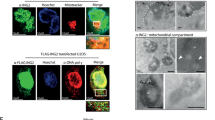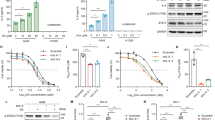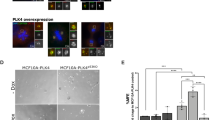Abstract
Little is known about the biological role of the phospholipase A2 receptor (PLA2R1) transmembrane protein. In recent years, PLA2R1 has been shown to have an important role in regulating tumor-suppressive responses via JAK2 activation, but the underlying mechanisms are largely undeciphered. In this study, we observed that PLA2R1 increases the mitochondrial content, judged by increased levels of numerous mitochondrial proteins, of the mitochondrial structural component cardiolipin, of the mitochondrial DNA content, and of the mitochondrial DNA replication and transcription factor TFAM. This effect of PLA2R1 relies on a transcriptional program controlled by the estrogen-related receptor alpha1 (ERRα) mitochondrial master regulator. Expression of ERRα and of its nucleus-encoded mitochondrial targets is upregulated upon PLA2R1 ectopic expression, and this effect is mediated by JAK2. Conversely, downregulation of PLA2R1 decreases the level of ERRα and of its nucleus-encoded mitochondrial targets. Finally, blocking the ERRα-controlled mitochondrial program largely inhibits the PLA2R1-induced tumor-suppressive response. Together, our data document ERRα and its mitochondrial program as downstream effectors of the PLA2R1-JAK2 pathway leading to oncosuppression.
This is a preview of subscription content, access via your institution
Access options
Subscribe to this journal
Receive 50 print issues and online access
$259.00 per year
only $5.18 per issue
Buy this article
- Purchase on Springer Link
- Instant access to full article PDF
Prices may be subject to local taxes which are calculated during checkout





Similar content being viewed by others
References
Augert A, Payre C, de Launoit Y, Gil J, Lambeau G, Bernard D . The M-type receptor PLA2R regulates senescence through the p53 pathway. EMBO Rep 2009; 10: 271–277.
Vindrieux D, Augert A, Girard CA, Gitenay D, Lallet-Daher H, Wiel C et al. PLA2R1 mediates tumor suppression by activating JAK2. Cancer Res 2013; 73: 6334–6345.
Augert A, Vindrieux D, Girard CA, Le Calvé B, Gras B, Ferrand M et al. PLA2R1 kills cancer cells by inducing mitochondrial stress. Free Radic Biol Med 2013; 65C: 969–977.
Vindrieux D, Devailly G, Augert A, Le CB, ferrand M, Pigny P et al. Repression of PLA2R1 by c-MYC and HIF-2alpha promotes cancer growth. Oncotarget 2014; 5: 1004–1013.
Bernard D, Vindrieux D . PLA2R1: expression and function in cancer. Biochim Biophys Acta 2014; 1846: 40–44.
Menschikowski M, Platzbecker U, Hagelgans A, Vogel M, Thiede C, Schonefeldt C et al. Aberrant methylation of the M-type phospholipase A(2) receptor gene in leukemic cells. BMC Cancer 2012; 12: 576.
Sonoda J, Laganiere J, Mehl IR, Barish GD, Chong LW, Li X et al. Nuclear receptor ERR alpha and coactivator PGC-1 beta are effectors of IFN-gamma-induced host defense. Genes Dev 2007; 21: 1909–1920.
Villena JA, Hock MB, Chang WY, Barcas JE, Giguere V, Kralli A . Orphan nuclear receptor estrogen-related receptor alpha is essential for adaptive thermogenesis. Proc Natl Acad Sci USA 2007; 104: 1418–1423.
Schreiber SN, Emter R, Hock MB, Knutti D, Cardenas J, Podvinec M et al. The estrogen-related receptor alpha (ERRalpha) functions in PPARgamma coactivator 1alpha (PGC-1alpha)-induced mitochondrial biogenesis. Proc Natl Acad Sci USA 2004; 101: 6472–6477.
Starr R, Willson TA, Viney EM, Murray LJ, Rayner JR, Jenkins BJ et al. A family of cytokine-inducible inhibitors of signalling. Nature 1997; 387: 917–921.
Schindler C, Darnell JE Jr . Transcriptional responses to polypeptide ligands: the JAK-STAT pathway. Annu Rev Biochem 1995; 64: 621–651.
Schindler C, Levy DE, Decker T . JAK-STAT signaling: from interferons to cytokines. J Biol Chem 2007; 282: 20059–20063.
Willy PJ, Murray IR, Qian J, Busch BB, Stevens Jr WC, Martin R et al. Regulation of PPARgamma coactivator 1alpha (PGC-1alpha) signaling by an estrogen-related receptor alpha (ERRalpha) ligand. Proc Natl Acad Sci USA 2004; 101: 8912–8917.
Bianco S, Sailland J, Vanacker JM . ERRs and cancers: effects on metabolism and on proliferation and migration capacities. J Steroid Biochem Mol Biol 2012; 130: 180–185.
Deblois G, Giguere V . Oestrogen-related receptors in breast cancer: control of cellular metabolism and beyond. Nat Rev Cancer 2013; 13: 27–36.
Miwa S, Jow H, Baty K, Johnson A, Czapiewski R, Saretzki G et al. Low abundance of the matrix arm of complex I in mitochondria predicts longevity in mice. Nat Commun 2014; 5: 3837.
Deblois G, Chahrour G, Perry MC, Sylvain-Drolet G, Muller WJ, Giguere V . Transcriptional control of the ERBB2 amplicon by ERRalpha and PGC-1beta promotes mammary gland tumorigenesis. Cancer Res 2010; 70: 10277–10287.
Fradet A, Sorel H, Bouazza L, Goehrig D, Depalle B, Bellahcene A et al. Dual function of ERRalpha in breast cancer and bone metastasis formation: implication of VEGF and osteoprotegerin. Cancer Res 2011; 71: 5728–5738.
Sailland J, Tribollet V, Forcet C, Billon C, Barenton B, Carnesecchi J et al. Estrogen-related receptor alpha decreases RHOA stability to induce orientated cell migration. Proc Natl Acad Sci USA 2014; 111: 15108–15113.
Hong EJ, Levasseur MP, Dufour CR, Perry MC, Giguere V . Loss of estrogen-related receptor alpha promotes hepatocarcinogenesis development via metabolic and inflammatory disturbances. Proc Natl Acad Sci USA 2013; 110: 17975–17980.
Ao A, Wang H, Kamarajugadda S, Lu J . Involvement of estrogen-related receptors in transcriptional response to hypoxia and growth of solid tumors. Proc Natl Acad Sci USA 2008; 105: 7821–7826.
Arany Z, Foo SY, Ma Y, Ruas JL, Bommi-Reddy A, Girnun G et al. HIF-independent regulation of VEGF and angiogenesis by the transcriptional coactivator PGC-1alpha. Nature 2008; 451: 1008–1012.
Zou C, Yu S, Xu Z, Wu D, Ng CF, Yao X et al. ERRalpha augments HIF-1 signalling by directly interacting with HIF-1alpha in normoxic and hypoxic prostate cancer cells. J Pathol 2014; 233: 61–73.
Li Y, Padmanabha D, Gentile LB, Dumur CI, Beckstead RB, Baker KD . HIF- and non-HIF-regulated hypoxic responses require the estrogen-related receptor in Drosophila melanogaster. PLoS Genet 2013; 9: e1003230.
Ferbeyre G, Moriggl R . The role of Stat5 transcription factors as tumor suppressors or oncogenes. Biochim Biophys Acta 2011; 1815: 104–114.
Manna S, Bostner J, Sun Y, Miller LD, Alayev A, Schwarts NS et al. ERRalpha is a marker of tamoxifen response and survival in triple-negative breast cancer. Clin Cancer Res 2015, e-pub ahead of print 5 November 2015.
Sasaki A, Inagaki-Ohara K, Yoshida T, Yamanaka A, Sasaki M, Yasukawa H et al. The N-terminal truncated isoform of SOCS3 translated from an alternative initiation AUG codon under stress conditions is stable due to the lack of a major ubiquitination site, Lys-6. J Biol Chem 2003; 278: 2432–2436.
Gallet M, Saidi S, Hay E, Photsavang J, Marty C, Sailland J et al. Repression of osteoblast maturation by ERRalpha accounts for bone loss induced by estrogen deficiency. PLoS One 2013; 8: e54837.
Devailly G, Grandin M, Perriaud L, Mathot P, Delcros JG, Bidet Y et al. Dynamics of MBD2 deposition across methylated DNA regions during malignant transformation of human mammary epithelial cells. Nucleic Acids Res 2015; 43: 5838–5854.
Acknowledgements
We thank the laboratory members for helpful discussions. This work was carried out with the support of the Association for International Cancer Research (AICR-11-0722) and the ANR (ANR-14-CE12-0003) for DB, the Groupe Pasteur Mutualité for LE and the Ligue contre le cancer, comité du Puy de Dome et de la Drome for JMV.
Author information
Authors and Affiliations
Corresponding author
Ethics declarations
Competing interests
The authors declare no conflict of interest.
Additional information
Supplementary Information accompanies this paper on the Oncogene website
Supplementary information
Rights and permissions
About this article
Cite this article
Griveau, A., Devailly, G., Eberst, L. et al. The PLA2R1-JAK2 pathway upregulates ERRα and its mitochondrial program to exert tumor-suppressive action. Oncogene 35, 5033–5042 (2016). https://doi.org/10.1038/onc.2016.43
Received:
Revised:
Accepted:
Published:
Issue Date:
DOI: https://doi.org/10.1038/onc.2016.43
This article is cited by
-
Estrogen-related receptor alpha in select host functions and cancer: new frontiers
Molecular and Cellular Biochemistry (2022)
-
PLA2R1 promotes DNA damage and inhibits spontaneous tumor formation during aging
Cell Death & Disease (2021)
-
Methylation of the Phospholipase A2 Receptor 1 Promoter Region in Childhood B Cell Acute Lymphoblastic Leukaemia
Scientific Reports (2020)



